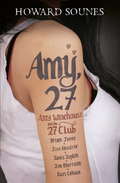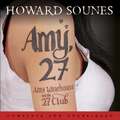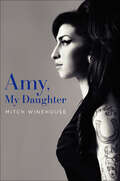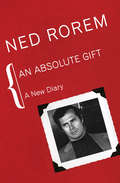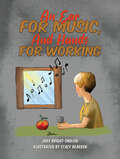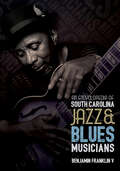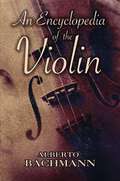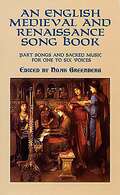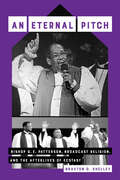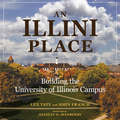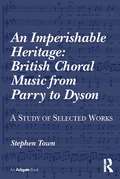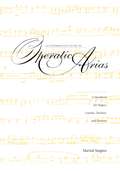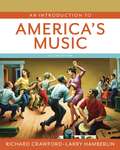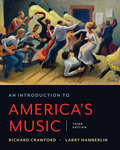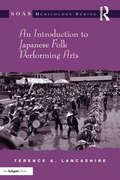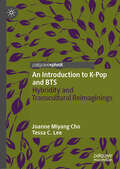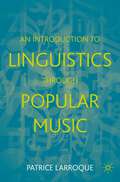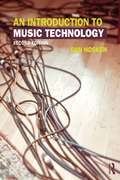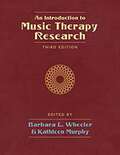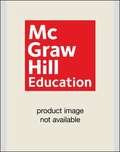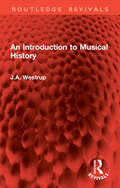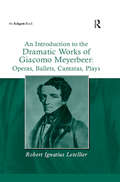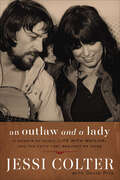- Table View
- List View
Amy, 27
by Howard SounesThe death of Amy Winehouse at the age of 27 was a tragedy.She was one of the brightest music stars in years -a brilliant, original song writer with a mighty voice and great personal charm. Amy was loveable, but troubled. She was as notorious for her messy personal life, drug addiction and alcoholism, as she was celebrated for her songs, and her death in 2011, while shocking, was not unexpected.Amy was also the latest in a series of iconic music stars who died at the same young age; starting with Brian Jones of the Rolling Stones whose death in 1969 was followed by Jimi Hendrix and Janis Joplin in 1970, Jim Morrison in 1971, and Kurt Cobain in 1994. All were gifted. All were dissipated. All were 27.The 27 Club was first used as a collective term for these lost souls after a comment by Kurt Cobain's mother. 'He's gone and joined that stupid club,' she said after Kurt shot himself. 'I told him not to ...'In this ground-breaking book, Howard Sounes delivers a detailed and insightful study of Amy Winehouse's life, and sets that life in the context of the 27 Club. That six big music stars died at 27 -- along with 44 less well-known names -- is on one level a coincidence. But behind this coincidence Sounes reveals is a disturbing common narrative that explains how these artists met their fate, and casts new light on Amy's death in particular.
Amy, 27
by Howard SounesThe death of Amy Winehouse at the age of 27 was a tragedy.She was one of the brightest music stars in years -a brilliant, original song writer with a mighty voice and great personal charm. Amy was loveable, but troubled. She was as notorious for her messy personal life, drug addiction and alcoholism, as she was celebrated for her songs, and her death in 2011, while shocking, was not unexpected.Amy was also the latest in a series of iconic music stars who died at the same young age; starting with Brian Jones of the Rolling Stones whose death in 1969 was followed by Jimi Hendrix and Janis Joplin in 1970, Jim Morrison in 1971, and Kurt Cobain in 1994. All were gifted. All were dissipated. All were 27.The 27 Club was first used as a collective term for these lost souls after a comment by Kurt Cobain's mother. 'He's gone and joined that stupid club,' she said after Kurt shot himself. 'I told him not to ...'In this ground-breaking book, Howard Sounes delivers a detailed and insightful study of Amy Winehouse's life, and sets that life in the context of the 27 Club. That six big music stars died at 27 -- along with 44 less well-known names -- is on one level a coincidence. But behind this coincidence Sounes reveals is a disturbing common narrative that explains how these artists met their fate, and casts new light on Amy's death in particular.(P)2013 Hodder & Stoughton
Amy, My Daughter
by Mitch WinehouseRevealing details about icon Amy Winehouse’s childhood, musical influences and substance abuse, this biography by her father “can’t fail to move”(The Sunday Times).The intimate, inside story of the life of multiple Grammy Award-winning singer and songwriter Amy Winehouse is told by the one person most able to tell it—Amy’s closest advisor, her inspiration, and best friend: her father, Mitch.Sifting fact from fiction, Mitch Winehouse reveals the events and the people that shaped Amy’s youth—from her mischievous childhood to her grandmother’s Jazz Age stories, to her father singing Frank Sinatra around the house. Shedding light on Amy’s musical coming-of-age, Mitch explores how she honed her distinctive sound, created her unforgettable look, and channeled her own life into hits such as “You Know I’m No Good”, “Rehab”, and “Back to Black” —some of the most memorable and personal pop music in years.Mitch holds nothing back about Amy’s addiction to drugs and alcohol and the toll it took on the family and friends who refused to give up on her. Dispelling many of the rumors about her tumultuous marriage to Blake Fielder-Civil, Mitch exposes the years of behind-the-scenes drama and explains how, for those who knew Amy in her last months, the greatest tragedy of all was that she finally appeared to be conquering her demons.Amy, My Daughter includes exclusive, never-before-seen photos and paints an open and honest portrait of one of the greatest musical talents of our time.“An unsparing portrait of addiction.” —The Times “Mitch does a fine job of fleshing out his daughter in all contradictory glory.” —Observer “An unflinchingly honest memoir.” —Independent
An Absolute Gift: A New Diary
by Ned RoremA magnificent collection of essays, opinions, and reflections on life, culture, art, love, and music—always lyrical, witty, and brazenly provocative—from one of the most acclaimed contemporary American composersTime magazine has called Ned Rorem &“the world&’s best composer of art songs.&” But his genius does not end in the realm of classical music. Rorem has a rare gift for writing, as well, and the wide acclaim that has greeted his memoirs, essay collections, and published diaries attest to this fact. An Absolute Gift is a cornucopia of Roremisms—essays, reviews, and opinions on a vast array of fascinating subjects, from music to film to drama to sex. Here also are candid diary entries, displaying the frankness and remarkable insight for which Rorem is known. Whether he&’s lambasting or celebrating the world&’s great musical works and their creators (and, according to Stephen Sondheim, &“He is one of the best writers about music that I have ever read&”), offering intensely personal musings on death and love, or brilliantly dissecting the artist&’s craft, Ned Rorem is always fascinating, always provocative, and enormously entertaining.
An Ear for Music, And Hands for Working
by Judy Bright-EnglishJust imagine being a young boy sitting behind your desk at home, and every morning you hear music and the sound of marching feet.But you&’re too short to see over the windowsill. The music passes by, and you wonder what it would be like to play with them. Then a gift from his housekeeper and some good news from his father gives this young boy a chance.
An Encyclopedia of South Carolina Jazz & Blues Musicians
by Benjamin Franklin VThis comprehensive A-to-Z reference is “an impressive contribution to jazz history and surprisingly good reading” (Michael Ullman, author of Jazz Lives).This informative bookdocuments the careers of South Carolina jazz and blues musicians from the nineteenth century to the present. The musicians range from the renowned (James Brown, Dizzy Gillespie), to the notable (Freddie Green, Josh White), the largely forgotten (Fud Livingston, Josie Miles), the obscure (Lottie Frost Hightower, Horace “Spoons” Williams), and the unknown (Vince Arnold, Johnny Wilson).Though the term “jazz” is commonly understood, if difficult to define, “blues” has evolved over time to include R&B, doo-wop, and soul. Performers in these genres are also represented, as are members of the Jenkins Orphanage bands of Charleston. Also covered are nineteenth-century musicians who performed what might be called proto-jazz or proto-blues in string bands, medicine shows, vaudeville, and the like.Organized alphabetically, from Johnny Acey to Webster Young, the entries include basic biographical information, South Carolina residences, career details, compositions, recordings as leaders and as band members, films, awards, websites, and lists of resources for additional reading. Former host of Jazz in Retrospect on NPR Benjamin Franklin V has ensured biographical accuracy to the greatest degree possible by consulting numerous public documents, and information in these records permitted him to dispel myths and correct misinformation that have surrounded South Carolina’s musical history for generations.“Elucidates South Carolina as a profoundly crucial puzzle piece alongside New Orleans, Chicago, Kansas City and New York.” —Harry Skoler, professor, Berklee College of MusicIncludes photos
An Encyclopedia of the Violin (Dover Books on Music)
by Alberto Bachmann"No list of twentieth-century landmarks in music reference would be valid without Bachmann's Encyclopedia."--American Reference Book Annual"If there were such an award as one for the best reprint of our day, surely this book by Alberto Bachmann would be way up front with the leaders."--American String TeacherOf the many books written about the violin, none offers the breadth and scope of this renowned reference. First published in 1925, it remains unsurpassed as a source of essential information on all aspects of the instrument. It traces the evolution of technique from the 1800s onward, in addition to examining the violin's construction and manufacture, listing American and European makers, and offering a biographic section on chamber music ensembles.Seventy-three rare photographs complement the text, which features an introduction by the legendary violinist Eugène Ysaÿe and a glossary of music and musical terms. Written by a concert violinist and composer, this remarkable handbook is a must for professionals, amateurs, teachers, and students.
An English Medieval and Renaissance Song Book: Part Songs and Sacred Music for One to Six Voices (Dover Song Collections)
by Noah Greenberg"An elegant anthology. The specialist will not miss the quiet sophistication with which the music has been selected and prepared. Some of it is printed here for the first time, and much of it has been edited anew." -- NotesThis treasury of 47 vocal works -- edited by Noah Greenberg, founder and former director of the New York Pro Musica Antiqua -- will delight all lovers of medieval and Renaissance music. Containing a wealth of both religious and secular music from the 12th to the 17th centuries, the collection covers a broad range of moods, from the hearty "Blow Thy Horne Thou Jolly Hunter" by William Cornysh to the reflective and elegiac "Cease Mine Eyes" by Thomas Morley.Of the religious works, nine were written for church services, including "Sanctus" by Henry IV and "Angús Dei" from a beautiful four-part mass by Thomas Tallis. Other religious songs in the collection come from England's rich tradition of popular religious lyric poetry, and include William Byrd's "Susanna Farye," the anonymously written "Deo Gracias Anglia" (The Agincort Carol), and Thomas Ravenscroft's "O Lord, Turne Now Away Thy Face" and "Remember O Thou Man."Approximately half of the songs are secular, some from the popular tradition and others from the courtly poets and musicians surrounding such musically inclined monarchs as Henry VIII -- who himself is represented in this collection with two charming songs, "With Owt Dyscorde" and "O My Hart." Among the notable composers of Tudor and Elizabethan England represented here are Orlando Gibbons, John Dowland, and Thomas Weelkes.
An Eternal Pitch: Bishop G. E. Patterson, Broadcast Religion, and the Afterlives of Ecstasy (Phono: Black Music and the Global Imagination #2)
by Braxton D. ShelleyAn Eternal Pitch examines the homiletic life and afterlife of Bishop G. E. Patterson, the dynamic spiritual leader of the Church of God in Christ from 2000 to 2007. Although Patterson died in 2007, his voice remains a staple of radio and television broadcast, and his sermons have taken on a life of their own online, where myriad YouTube, Facebook, Instagram, and TikTok users enact innovative forms of religious broadcasting. Their preoccupation with Patterson’s "Afterliveness" punctuates the significance of Patterson’s preoccupation with musical repetition: across the decades of Patterson’s ministry, a set of musical gestures recur as sonic channels, bringing an individual sermon into contact with scripture’s eternal transmission.
An Illini Place: Building the University of Illinois Campus
by Incoronata Inserra John Franch Lex TateWhy does the University of Illinois campus at Urbana-Champaign look as it does today? Drawing on a wealth of research and featuring more than one hundred color photographs, An Illini Place provides an engrossing and beautiful answer to that question. Lex Tate and John Franch trace the story of the university's evolution through its buildings. Oral histories, official reports, dedication programs, and developmental plans both practical and quixotic inform the story. The authors also provide special chapters on campus icons and on the buildings, arenas and other spaces made possible by donors and friends of the university. Adding to the experience is a web companion that includes profiles of the planners, architects, and presidents instrumental in the campus's growth, plus an illustrated inventory of current and former campus plans and buildings.
An Imperishable Heritage: A Study of Selected Works
by Stephen TownThe rehabilitation of British music began with Hubert Parry and Charles Villiers Stanford. Ralph Vaughan Williams assisted in its emancipation from continental models, while Gerald Finzi, Edmund Rubbra and George Dyson flourished in its independence. Stephen Town's survey of Choral Music of the English Musical Renaissance is rooted in close examination of selected works from these composers. Town collates the substantial secondary literature on these composers, and brings to bear his own study of the autograph manuscripts. The latter form an unparalleled record of compositional process and shed new light on the compositions as they have come down to us in their published and recorded form. This close study of the sources allows Town to identify for the first time instances of similarity and imitation, continuities and connections between the works.
An Interpretive Guide to Operatic Arias: A Handbook for Singers, Coaches, Teachers, and Students
by Martial SingherA premier singer and master teacher here tells other singers how to get the most from 151 famous arias selected for their popularity or their greatness from 66 operas, ranging in time and style from Christopher Gluck to Carlisle Floyd, from Mozart to Menotti. “The most memorable thrills in an opera singer's life,” according to the author's Introduction, “may easily derive from the great arias in his or her repertoire.”This book continues the work Martial Singher has done, in performances, in concerts, and in master classes and lessons, by drawing attention “not only to precise features of text, notes, and markings but also to psychological motivations and emotional impulses, to laughter and tears, to technical skills, to strokes of genius, and even here and there to variations from the original works that have proved to be fortunate.”For each aria, the author gives the dramatic and musical context, advice about interpretation, and the lyric—with the original language (if it is not English) and an idiomatic American English translation, in parallel columns. The major operatic traditions—French, German, Italian, Russian, and American—are represented, as are the major voice types—soprano, mezzo-soprano, tenor, baritone, bass-baritone, and bass.The dramatic context is not a mere summary of the plot but is a penetrating and often witty personality sketch of an operatic character in the midst of a situation. The musical context is presented with the dramatic situation in a cleverly integrated way. Suggestions about interpretation, often illustrated with musical notation and phonetic symbols, are interspersed among the author's explication of the music and the action. An overview of Martial Singher’s approach—based on fifty years of experience on stage in a hundred roles and in class at four leading conservatories—is presented in his Introduction. As the reader approaches each opera discussed in this book, he or she experiences the feeling of participation in a rehearsal on stage under an urbane though demanding coach and director.The Interpretive Guide will be of value to professional singers as a source of reference or renewed inspiration and a memory refresher, to coaches for checking and broadening personal impressions, to young singers and students for learning, to teachers who have enjoyed less than a half century of experience, and to opera broadcast listeners and telecast viewers who want to understand what goes into the sounds and sights that delight them.
An Interpretive Guide to Operatic Arias: A Handbook for Singers, Coaches, Teachers, and Students
by Martial SingherA premier singer and master teacher here tells other singers how to get the most from 151 famous arias selected for their popularity or their greatness from 66 operas, ranging in time and style from Christopher Gluck to Carlisle Floyd, from Mozart to Menotti. “The most memorable thrills in an opera singer's life,” according to the author's Introduction, “may easily derive from the great arias in his or her repertoire.”This book continues the work Martial Singher has done, in performances, in concerts, and in master classes and lessons, by drawing attention “not only to precise features of text, notes, and markings but also to psychological motivations and emotional impulses, to laughter and tears, to technical skills, to strokes of genius, and even here and there to variations from the original works that have proved to be fortunate.”For each aria, the author gives the dramatic and musical context, advice about interpretation, and the lyric—with the original language (if it is not English) and an idiomatic American English translation, in parallel columns. The major operatic traditions—French, German, Italian, Russian, and American—are represented, as are the major voice types—soprano, mezzo-soprano, tenor, baritone, bass-baritone, and bass.The dramatic context is not a mere summary of the plot but is a penetrating and often witty personality sketch of an operatic character in the midst of a situation. The musical context is presented with the dramatic situation in a cleverly integrated way. Suggestions about interpretation, often illustrated with musical notation and phonetic symbols, are interspersed among the author's explication of the music and the action. An overview of Martial Singher’s approach—based on fifty years of experience on stage in a hundred roles and in class at four leading conservatories—is presented in his Introduction. As the reader approaches each opera discussed in this book, he or she experiences the feeling of participation in a rehearsal on stage under an urbane though demanding coach and director.The Interpretive Guide will be of value to professional singers as a source of reference or renewed inspiration and a memory refresher, to coaches for checking and broadening personal impressions, to young singers and students for learning, to teachers who have enjoyed less than a half century of experience, and to opera broadcast listeners and telecast viewers who want to understand what goes into the sounds and sights that delight them.
An Introduction to America's Music
by Richard Crawford Larry HamberlinRichard Crawford and Larry Hamberlin show how the lively interactions between the folk, popular, and classical spheres have made American music resonate with audiences around the world. Students will learn how to listen critically to eighty-eight pieces in all the major styles and genres, while gaining a clearer understanding of music's role in the history of American society, business, and technology.
An Introduction to America's Music (Third Edition)
by Richard Crawford Larry HamberlinAn ear-opening exploration of music's New World, from Puritan psalmody to Hamilton Authors Richard Crawford and Larry Hamberlin use 90 pieces to show how the lively interactions among the folk, popular, and classical spheres have made American music resonate with audiences around the world. Along the way, students gain a clearer understanding of music's role in the history of American society, business, and technology. This purchase offers access to the digital ebook only.
An Introduction to Japanese Folk Performing Arts (SOAS Studies in Music Series)
by Terence A. LancashireJapanese folk performing arts incorporate a body of entertainments that range from the ritual to the secular. They may be the ritual dances at Shinto shrines performed to summon and entertain deities; group dances to drive away disease-bearing spirits; or theatrical mime to portray the tenets of Buddhist teachings. These ritual entertainments can have histories of a thousand years or more and, with such histories, some have served as the inspiration for the urban entertainments of no, kabuki and bunraku puppetry. The flow of that inspiration, however, has not always been one way. Elements taken from these urban forms could also be used to enhance the appeal of ritual dance and drama. And, in time, these urban entertainments too came to be performed in rural or regional settings and today are similarly considered folk performing arts. Professor Terence Lancashire provides a valuable introductory guide to the major performance types as understood by Japanese scholars.
An Introduction to K-Pop and BTS: Hybridity and Transcultural Reimaginings
by Joanne Miyang Cho Tessa C. LeeThis Palgrave Pivot examines a key area of the Korean Wave or Hallyu, which stands for the global popularity of South Korean popular culture that started in the 1990s. While K-dramas (Korean dramas) have found many viewers throughout Asian countries and some Western countries in recent years, K-pop (Korean popular music) has had broader appeal not only to Asian audiences, but also American (North and South), European, and Middle-Eastern audiences. This book&’s unique contribution is to provide a concise and succinct analysis of K-pop from transcultural perspectives through its most famous example, BTS. The first chapter contextualizes K-pop within the Korean Wave movement. The second and third chapters provide a history of K-Pop, spanning from Seo Taiji and Boys in the early 1990s to the present (including BTS and Blackpink), and presents K-pop as a glocalized phenomenon. The fourth, fifth, and sixth chapters critically examine the most prominent band in the K-pop world, BTS, and the unique connections to their transnational fandom called ARMY.
An Introduction to Linguistics through Popular Music
by Patrice LarroqueThis textbook introduces the field of linguistics, demonstrating syntactic categories, morphological structures, phonological/metric structures, syllable structures, and varieties of English in an accessible way by using portions of song lyrics from popular music. The varieties of English covered include Received Pronunciation (RP) and General American, as well as some features of Australian English, southern US varieties, and Scottish English. Drawing on shared characteristics between language and music, including metrical structure, the author suggests a different approach to linguistic analysis and the description of spoken language. The book introduces both students and instructors to a novel and engaging method of description, and provides a fresh vocabulary with which to start thinking about language. It demonstrates complex topics by using music as a fun and familiar starting point, and will be an ideal resource for introductory linguistics courses worldwide.
An Introduction to Music Technology
by Dan HoskenAn Introduction to Music Technology, Second Edition provides a clear overview of the essential elements of music technology for today's musician. This book focuses on the topics that underlie the hardware and software in use today: Sound, Audio, MIDI, Computer Notation, and Computer- Assisted Instruction. Appendices cover necessary computer hardware and software concepts. Written for both music technology majors and non-majors, this textbook introduces fundamental principles and practices so students can learn to work with a wide range of software programs, adapt to new music technologies, and apply music technology in their performance, composition, teaching, and analysis. Features: Thorough explanations of key topics in music technology Content applicable to all software and hardware, not linked to just one piece of software or gear In-depth discussion of digital audio topics, such as sampling rates, resolutions, and file formats Explanations of standard audio plug-ins including dynamics processors, EQs, and delay based effects Coverage of synthesis and sampling in software instruments Pedagogical features, including: Further Reading sections that allow the student to delve deeper into topics of interest Suggested Activities that can be carried out with a variety of different programs Key Terms at the end of each chapter What Do I Need? Chapters covering the types of hardware and software needed in order to put together Audio and MIDI systems A companion website with links to audio examples that demonstrate various concepts, step-by-step tutorials, relevant hardware, software, and additional audio and video resources. The new edition has been fully updated to cover new technologies that have emerged since the first edition, including iOS and mobile platforms, online notation software, alternate controllers, and Open Sound Control (OSC).
An Introduction to Music Therapy Research
by Barbara L. WheelerAn introductory overview of how research has been conceived and implemented in music therapy over the last several decades. The book was designed for those who are beginning their studies in music therapy research, and it is especially well-suited for use as an accompaniment to classroom instruction. <P><P> Seventeen of the chapters were excerpted from Music Therapy Research (3rd Edition), a much larger volume of 68 chapters that gives considerable detail on numerous topics and sub-topics. In addition, three chapters (15, 16, 17) were specially written to provide a birds-eye view of some of the chapters that were not included, and in particular, those chapters in the larger book that examined the numerous methodological designs and approaches used in objectivist, interpretivist and other types of music therapy research.
An Introduction to Music Therapy Theory and Practice Third Edition
by William B. Davis Kate E. Gfeller Michael H. Thaut"An Introduction to Music Therapy: Theory and Practice, third edition, provides a comprehensive overview of the practice of music therapy for the 21st century. It looks at where we have been, where we are today, and where we might be in the future. Combining sound pedagogy with recent research findings, this new edition has been updated and expanded to reflect changes in music therapy practice over the past nine years.
An Introduction to Music and Art in the Western World (10th edition)
by Milo Wold Edmund Cykler Gary Martin James MillerAn undergraduate introduction to the music, painting, sculpture, and architecture of the Western world, featuring chapter objectives and summaries, pronunciation guides, and chronologies. Covers various periods from the ancient Greeks through the arts today, and includes material on the arts and society and the organization of the elements of art and music. This 10th edition contains increased recognition of women and minority artists, and boxes on selected individual works. Annotation c. by Book News, Inc., Portland, Or.
An Introduction to Musical History (Routledge Revivals)
by J.A. WestrupFirst published in 1955, An Introduction to Musical History is not just another short history of music, but a discussion of its sources and background. It explains how we derive our knowledge of the music of the past, and how music has been affected by its social and political background. Such topics as the influence of language and racial characteristics find their place here, as well as the contributions made by literature and painting. Some of the problems presented by musical history are examined, and an indication is given of the best method of studying it. This book will be an interesting read for students and researchers of music.
An Introduction to the Dramatic Works of Giacomo Meyerbeer: Operas, Ballets, Cantatas, Plays
by Robert Ignatius LetellierGiacomo Meyerbeer (1791-1864) was a great musical dramatist in his own right. The fame of his operas rests on his radical treatment of form, his development of scenic complexes and greater plasticity of structure and melody, his dynamic use of the orchestra, and close attention to all aspects of presentation and production, all of which set new standards in Romantic opera and dramaturgy. This book carries forward the process of rediscovery and reassessment of Meyerbeer‘s artincluding not just his famous French operas, but also his German and Italian ones placing them in the context of his entire dramatic oeuvre, including his ballets, oratorios, cantatas and incidental music. From Meyerbeer‘s first stage presentation in 1810 to his great posthumous accolade in 1865, some 24 works mark the unfolding of this life lived for dramatic music. The reputation of the famous four grand operas may well live on in the public consciousness, but the other works remain largely unknown. This book provides an approachable introduction to them. The works have been divided into their generic types for quick reference and helpful association, and placed within the context of the composer‘s life and artistic development. Each section unfolds a brief history of the work‘s origins, an account of the plot, a critical survey of some of its musical characteristics, and a record of its performance history. Robert Letellier examines each work from a dramaturgical view point, including the essential often challenging philosophical and historical elements in the scenarios, and how these concepts were translated musically onto the stage. A series of portraits and stage iconography assist in bringing the works to life.
An Outlaw and a Lady: A Memoir of Music, Life with Waylon, and the Faith that Brought Me Home
by David Ritz Jessi ColterRenowned songwriter, singer, and wife of Waylon Jennings writes an intimate, enormously entertaining memoir of American music, of life with Waylon and the Outlaws, and of faith lost and found.The daughter of a Pentecostal evangelist and a race-car driver, Jessi Colter played piano and sang in church before leaving Arizona to tour with rock-n-roll pioneer Duane Eddy, whom she married. Colter became a successful recording artist, appearing on American Bandstand and befriending stars such as the Everly Brothers and Chet Atkins, while her songs were recorded by Nancy Sinatra, Dottie West, and others. Her marriage to Eddy didn&’t last, however, and in 1969 she married the electrifying Waylon Jennings. Together, they made their home in Nashville which, in the 1970s, was ground zero for roots music, drawing Bob Dylan, Johnny Cash, Willie Nelson, Kris Kristofferson, Shel Silverstein, and others to the Nashville Sound. And Jessi was at the center of it all, the only woman on the landmark Wanted: The Outlaws album, therecord that launched the Outlaw Country genre and was the first country album to go platinum. She also tasted personal commercial success with the #1-single &“I&’m Not Lisa.&”But offstage, life was a challenge, as Waylon pursued his addictions and battled his demons. Having drifted from the church as a young woman, Jessi returned to her faith and found in it a source of strength in the turmoil of living with Waylon. In the 1980s, Waylon helped launch the super group The Highwaymen with Willie Nelson, Johnny Cash, and Kris Kristofferson, and the hits kept rolling, as did Waylon&’s reckless living. Amid it all, Jessi faithfully prayed for her husband until finally, at Thanksgiving 2001, Waylon found Jesus, just months before he died. An Outlaw and a Lady is a powerful story of American music, of love in the midst of heartache, and of faith that sustains.
